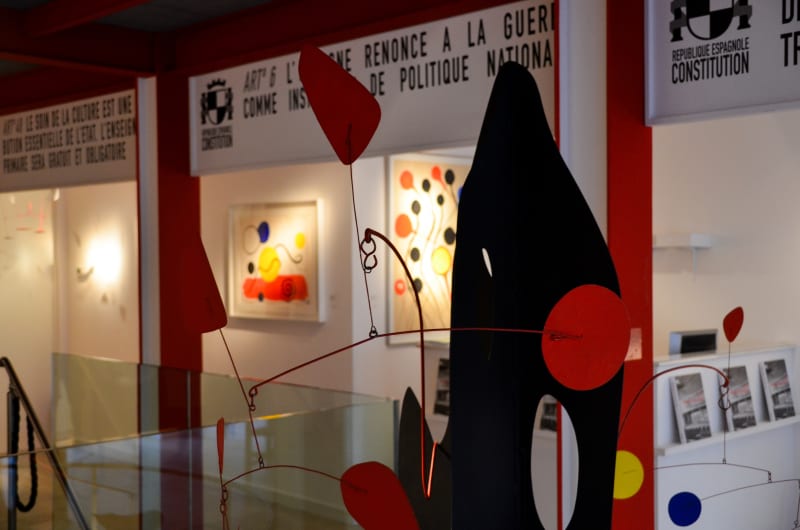"Art Revolutionaries" is a historically accurate project featuring works by Pablo Picasso, Joan Miró, Alexander Calder and Julio González. The exhibition has been the result of a year-long research and document gathering; intense work has been carried out, full of interesting findings and discoveries, that enables us to show and evoke the Spanish Pavilion in a most accurate and faithful way, recreating part of the building and allowing the viewer to feel immersed in the atmosphere of that period.
Including seventeen paintings, drawings and sculptures, the selection of works — among which Standing Woman and Sitting Woman (1939) and Woman Head (1957) by Picasso, Untitled (1934) and Métamorphose (1936) by Miró, and The Red Base (1969) and Crag with Yellow Boomerang and Red Eggplant (1974) by Calder, stand out— shares a very close link with those presented by the republican artists in 1937. Many of them are created by the same technique, style or have the same story behind its conception.
80 years since the exhibition in 1937
The exhibition commemorates the 80th anniversary of the "Exposition Internationale des Arts et des Techniques appliquées à la Vie Moderne", in 1937 in Paris, with the aim of paying homage to the artists who took place in it.
The curator of the show, Juan Manuel Bonet, former director of the Museo Nacional Centro de Arte Reina Sofía in Madrid, explains: “Everyday there is an increasing awareness that the International Exposition was an exceptional event”. The Spanish Pavilion for the Universal Exposition of Paris, 1937, was created in a period of great turbulence, as Spain was in the midst of a Civil War. For this reason, the Pavilion presented by the Spanish Republican Government became a strategic platform to vindicate the tragic situation the country was going through.
The architects who designed the building were Josep Lluís Sert and Luis Lacasa, and José Gaos was the curator of the exhibition. The main artists: Picasso (Guernica), Miró (The Reaper), Calder (Mercury Fountain) and González (Montserrat) created some of the most relevant pieces in art history.
In this regard, Picasso commented: “Maybe, later on, some art historian will prove that my painting has changed because of the war. I myself don’t know”. According to Joan Miró’s grandson Joan Punyet Miró: “The Reaper and the Guernica seemed political propaganda posters of monumental dimensions. Nobody chose a solid and durable support, because they knew in advance that those works were ephemeral, just to make an impact, and that they would finally disappear together with the pavilion.”
Furthermore, a reconstruction of El Segador (The Reaper) –approved by the Fundació Joan Miró of Barcelona- will be shown. Thus, the exhibition wish to express, with the utmost enthusiasm and rigor, admiration for a group of brave artists who were committed to their ideals and their nation and who fought for them from their particular trenches: artistic creation.
The connection with London
The exhibition has an important archival and documentation section. Alongside Miró’s famous mural, we are going to show the involvement of the Artists International Association (an exhibiting society founded in London in 1933, which held exhibitions and events to promote and support various left-of-center political causes); they made many different activities to raise money for Spain.
“Art Revolutionaries” is an exhibition whose main protagonists are liberty and oppression, hope and despair. A crucial moment in which everything was at stake and in which, finally, these artists lost a cruel war that forced them into exile, disrupting forever the course of a whole generation of incomparably talented creators.


